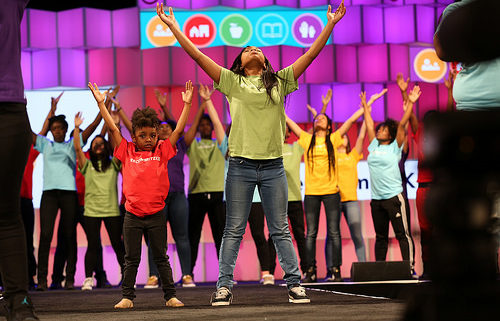The Promise to America’s Children and Youth
20 years ago last week, five living Presidents and Nancy Reagan were gathered together in Philadelphia at an event called the President’s Summit for America’s Future, hosted by General Colin Powell, to make a promise to our children and youth. Leaders from all sectors and all 50 states, along with young people from hundreds of communities, committed to one another and the nation that together they would provide all youth access to the critical success factors that they needed to thrive: a life filled with caring adults; safe spaces to learn, play, and grow; health and wellness for the best start in life; skills for meaningful and prosperous employment; and opportunities to share their gifts with others through service. They called these the “Five Promises,” and advancing them became the rallying cry for the America’s Promise Alliance.
I had a special seat at that Summit, even though I rarely had the chance to sit down while I was there. As a staff member of America’s Promise, I managed the logistics and much of the programming for the event. One of my fondest memories is of calling the Philadelphia Convention and Visitors Bureau to book the venue: “Hello, I’ll be bringing all the living Presidents to town for a Summit next year, and I’d like to reserve every hotel room in the city for 4 days.” There was silence on the other end of the line…then finally, “Who are you? Where are you calling from? Presidents of what?”
That was the start to a career defining experience for me, and it has since shaped every role in my professional life.
Last week, America’s Promise celebrated its 20th anniversary in New York City, an event that inspired us all to #Recommit2Kids. Led again by Colin and Alma Powell, the event featured President Clinton and a line-up of incredible speakers, young people, and performers who passionately made the case once again that we must help guide all of our nation’s children to a life of opportunity, fulfillment, prosperity, and contribution. This time I was a guest, and yes, I was glued to my seat the entire time.
It was heartening to see that America’s Promise has maintained its relevance for a new generation of young people, and even more gratifying to see how much has been accomplished since 1997. And yet, I found myself impatient and disappointed that we haven’t yet solved so many of the root problems that continue to plague or nation’s youth – especially those living in financial, social, or spiritual poverty.
“We know, in the quiet of conscience, that our children deserve better.
They deserve a life that rewards their dreams, a life of opportunity, unburdened by injustice. Equal opportunity is the defining promise of our country. It is a commitment that should unite right and left, rural and urban, rich and poor. Without equality of opportunity, economic differences harden through generations in a way that is inconsistent with our nation’s ideals.” Colin and Alma Powell
20 years later, I am still optimistic that we can expedite our progress because of the evolution of the conversation since 1997. Having participated in both events, it was evident to me that we’ve grown as a people to be more accepting, more inventive, and more precise. We’ve grown as a culture where inclusivity and equity are the expectations, and exclusion and inequity are called out for what they are. The quality of the dialogue is so much richer today than it was a generation ago in Philadelphia.
Consider these themes that resonated throughout the event:
- Identity: Young people celebrated who they are, not what they’ve done. The amazing and talented IMPACT Rep Theater and City Kids loudly and proudly shared their truths with us in performance of song, dance, and poetry. They expressed their authentic identities in ways that wasn’t safe for them to do 20 years ago, and we, as adults in the audience, embraced them with love.
“It shouldn’t require heroism to be a child.” Tiffany Yu
- Data: Our embrace of data in the past 20 years has shed light on problems and the solutions that can be scaled for more effective intervention. For example, Nadine Burke Harris from the Center for Youth Wellness shared research on the biological consequences of the toxic stress that is caused by childhood adversity, including increased heart disease, depression, and other health risks for children that can carry into their adult years. Her solution is to ensure that educators and pediatricians know how to screen for and intervene in adverse childhood experiences, before they become biological aftermaths.
- Equity: Nearly every speaker spoke to the need for universal equity for our children and youth. Not just equality; equity. Not just diversity; inclusion. And not about the bad choices that kids make, but about our failure as a society to provide all kids with sanctuary so they can survive and thrive. In 1997 we talked about equality, diversity, and dare I say, the blaming of parents. We know better now, and even though we have miles to go, I was inspired by the conversation and I believe that working together, we can achieve the equity that all kids deserve.
“In order to help children at risk, we have to be able to do things that are uncomfortable.” Bryan Stevenson
- Reach: There were about 800 people in the room at the Marriott Marquis this week, but there were well over 1 million people following the live stream and social media conversation. As Alma Powell pointed out, this tremendous increase in reach is something that was not available to us in 1997. And since the event, the retweets and reposts have exponentially exposed people to the issues facing children and youth.
There is so much to be done for our kids and for our nation. We must never rest at the sight of injustice and inequity. While there are no excuses for failing to be true to the ideals we hold so dear, I see progress in the quality of the conversation and the solutions we’re advancing today. I have tremendous hope in the promise for America, and I am #Recommitted2Kids.




 Check out our new
Check out our new